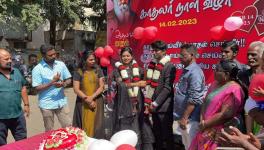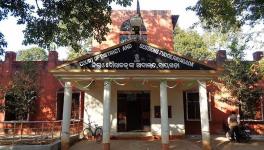The Real-Life Communist Heroes of 'Jai Bhim'
Image Courtesy: Live Law
Jai Bhim, directed by TJ Gnanavel, is an uplifting movie, based on true events. It tells you that another world – that of justice and hope – is possible. But perhaps more interestingly, it is a movie in which the communists have not been erased, very much in contrast to what mainstream movies have been doing even while talking about real-life struggles where communists played a leading role.
Communists are right at the centre stage in Jai Bhim, which narrates the story of Sengani (played by Lijomol Jose), a woman from the Irular tribe of Tamil Nadu who fights for justice for her husband Rajakannu (K Manikandan), who went missing from police custody. Sengani is helped in this battle by the selfless lawyer Chandru (Suriya), a communist who is actively involved in advancing the rights of workers and lawyers. The others who help Sengani are also communists—activists of the Communist Party and a teacher who is involved in a literacy movement spearheaded by the communist-led popular science movement.
Caste and class
The film opens with the depiction of the caste chasm in society with the police asking the surnames of prisoners to decide whom to release. Only upper- and intermediate-caste prisoners are released. Under pressure to nab the culprits of several pending cases, the police scapegoat the prisoners belonging to the lower castes.
In another scene, advocate Chandru is shown participating in a programme where children dress up as prominent Indian leaders. “All the important leaders, like Gandhi and Nehru, are here. How come only Ambedkar isn’t here?” he remarks.
The convergence of caste and class is depicted in the movie quite early. “I have made so many bricks with these hands. Yet I cannot build one brick for my own house,” Rajakannu mutters as he mends his mud house, echoing something that communists have repeated since the 19th century—workers produce everything yet they own nothing.
The tribals are landless; they have neither proof of residence nor ration cards. Hence, the authorities refuse to issue them voter identity cards. The poor and the marginalised are denied even the basic rights that a bourgeois democracy is supposed to grant to its citizens.
There is the clear recognition that caste oppression cannot be addressed without addressing the class question. Among the demands that Chandru raises to provide a dignified life to the complainant is the grant of land.
Communist imagery
Communist imagery is present throughout the film. The wall behind Chandru has a portrait bust of Karl Marx. He participates in workers’ protests with protesters holding the Red Flag. He puts up noticesof the Communist Party on walls.
The Communist Party of India (Marxist) [CPI(M)] office at Munnar, Kerala gets a cameo appearance, with the protagonists sitting near a fire and conversing. It seems that they were staying over at the office during their trip, showing the camaraderie that communist party members share cutting across geography and language.
In the concluding scene, which is viral on social media, Chandru and the daughter of Sengani and Rajakannu read a newspaper together. Right in front of them on the table is a bust of Vladimir Lenin. Many viewers have interpreted this as a signal that Lenin (or more precisely, Marxism-Leninism) is the way forward.
Real-life heroes
Jai Bhim is based on events that occurred at Muthanai village, Cuddalore district, in 1993. Sengani’s character is based on Parvathy, who fought an uphill battle to get justice for her husband Rajakannu. They belonged to the Kuravar tribe, whose members are mostly agricultural workers. The people who supported her in the tough battle were mostly communists.
Opposition parties, such as CPI(M), DMK, Congress and Pattali Makkal Katchi, had sought justice for Parvathy but it was only the communists who carried the struggle forward till the end.
Justice K Chandru
K Chandru was one of the founder leaders of the Students’ Federation of India in Tamil Nadu. After completing his law degree in 1976, he started his practice. He was one of the founder leaders of the left-wing All India Lawyers Union (AILU) and was an office-bearer of AILU’s Tamil Nadu unit until his elevation as a Judge.
Jai Bhim is based on a case Chandru took up when he was an advocate at the Madras High Court (HC)—one of the many legal battles he fought for the marginalised. At the end of the case, the court ordered Rs 5,000 to be paid to Chandru as cost. He sent the amount to Mythili Sivaraman, a leader of the CPI(M) and the All India Democratic Women’s Association, saying, “It may help them fight the cause of other women.”
In 2006, K Chandru was appointed a Judge of the Madras HC. He took a stand against many colonial customs at the court. He disposed of a record 96,000 cases before retiring in March 2013. Among his landmark judgments were “rulings on common burial grounds irrespective of caste; community-based reservation in [appointments to posts at] noon meal centres; women becoming priests in temples; and doing away with police permission to stage plays.” He declared his assets both at the time of his appointment and retirement.
KR Govindan
It was KR Govindan, a local CPI(M) leader and vice-president of Muthanai panchayat, who registered the first protest on the Rajakannu case. A member of the CPI(M)’s Kammapuram Taluk Committee, he faced threats and was attacked for standing with Parvathy and Rajakannu. Govindan’s comrades protected him for many years. He was also offered huge sums of money to withdraw from the case, but he continued supporting Parvathy for 13 years even at the cost of postponing his marriage.
KR Govindan
R Rajmohan
The CPI(M) organised protests in front of the police station demanding that the truth behind Rajakannu’s disappearance be made public. CPI(M) Kammapuram Taluk secretary R Rajmohan intervened in the issue on the basis of the information he received from Govindan. He informed the district committee about the issue and carried the struggle forward. A police case regarding Rajakannu’s disappearance was filed following the intervention by Rajmohan and the CPI(M) district committee.
R Rajmohan
K Balakrishnan
The intervention of K Balakrishnan, who was the CPI(M)’s Cuddalore district secretary, was crucial. He suggested a legal recourse to Parvathy and brought the case to the attention of the CPI(M) state committee, eventually leading to Chandru being roped in for the case.
Balakrishnan became a member of the Tamil Nadu Legislative Assembly from Chidambaram constituency in 2011, and is now the CPI(M)’s Tamil Nadu state secretary.
K Balakrishnan
Arivoli Iyakkam
The movie depicts a teacher who stands with Sengani throughout the case. The teacher is part of the literacy programme Arivoli Iyakkam (which literally means “enlightenment movement”). It was a state-sponsored literacy programme during the early 1990s. The CPI(M)-led Tamil Nadu Science Forum (TNSF) was the nodal organisation which ran the programme. Communist leader G Ramakrishnan guided the Rajakannu case from the CPI(M) State Secretariat; he was in charge of TNSF when the incident happened.
Communist-led struggles against caste and tribal oppression
The communist movement in Tamil Nadu has a long history of waging intense battles against class exploitation and the social oppression of marginalised communities, like Dalits and Adivasis. Keezhvenmani and Vachathi are among the most well-known symbols of such struggles.
Keezhvenmani, a village in present-day Nagapattinam district, is the place where 44 Dalit workers were massacred by landlords in 1968 in retaliation to the struggles they waged under the banner of the communist-led Agricultural Workers’ Union. While the judiciary failed to deliver justice in the case, the struggle for land and against caste oppression led by the CPI(M) gathered strength in the subsequent years. Consequently, the landless Dalit families became cultivating peasants owning small landholdings, and wage rates increased. (The plot of the 2019 Tamil movie Asuran was inspired by the Keezhvenmani massacre, but it makes no reference to the communist movement.)
Vachathi is a tribal hamlet in northern Tamil Nadu where 18 women were raped, men assaulted, their houses looted and destroyed and cattle killed by the police and forest and revenue personnel in 1992. The fight for justice for the tribals was led by the CPI(M), with party state secretary A Nallasivan filing petitions in the High Court and the Supreme Court.
In 2011, all the 215 surviving accused of the total 269—including four Indian Forest Service officers—were sentenced by a trial court. The communist-led Tamil Nadu Tribal Association (TNTA) played a major role in this protracted political and legal struggle. It was a writ petition filed by P Shanmugam, who was the general secretary of TNTA and who is now a member of the CPI(M) State Secretariat, which led to the appointment of a special court and a special prosecutor in the case.
The Tamil Nadu Untouchability Eradication Front (TNUEF), a broad-based organisation led by the CPI(M), has waged numerous struggles against caste oppression since its founding in 2007. Its struggles have resulted in many victories, including the demolition of caste walls erected to keep Dalits away in various places in the state—starting with the untouchability wall in Uthapuram, in Madurai district—and the winning of inner-caste reservation for Arunthathiyars, a Dalit community.
From 2007 to 2019, the temple-entry struggles of the TNUEF led to Dalits successfully entering 29 temples where they were previously denied entry. . TNUEF has also intervened in many cases of honour killing and led fights against practices such as the two-tumbler system at tea shops, denial of hair-cut to Dalits in salons and access to public pathways.
Recognising the key role that the struggle for land plays in the fight against caste oppression, TNUEF has led many struggles to reclaim Panchami land allocated to Dalits but occupied by others. Recent protests by TNUEF, CPI(M), All India Kisan Sabha and TNTA have led to the reclamation of Panchami land in Dindigul, Tiruvannamalai, Tiruvallur and Erode districts.
Three families belonging to the Irular tribe are among those whose lands were reclaimed as a result of this struggle. The land reclamation protest was organised on September 30, the death anniversary of communist leader B Srinivasa Rao, who led many fights against atrocities on agricultural labourers, most of whom were Dalits, in the Cauvery River delta districts.
More public attention being brought to such issues and struggles through films such as Jai Bhim is certainly a welcome development.
(Subin Dennis is an economist and a researcher at Tricontinental Research.)
Get the latest reports & analysis with people's perspective on Protests, movements & deep analytical videos, discussions of the current affairs in your Telegram app. Subscribe to NewsClick's Telegram channel & get Real-Time updates on stories, as they get published on our website.
























